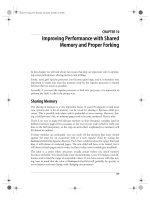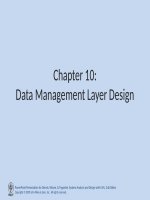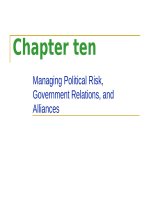Lecture E-Commerce - Chapter 10: E-commerce technology solution, management policies and payment systems
Bạn đang xem bản rút gọn của tài liệu. Xem và tải ngay bản đầy đủ của tài liệu tại đây (1.67 MB, 38 trang )
CSC 330 E-Commerce
Teacher
Ahmed Mumtaz Mustehsan
GM-IT CIIT Islamabad
Virtual Campus, CIIT
COMSATS Institute of Information Technology
T1-Lecture-10
T1-Lecture-10
E Commerce Technology Solution,
Management policies and Payment
Systems
Chapter-04
Part-II
For Lecture Material/Slides Thanks to: Copyright © 2010 Pearson Education, Inc
Objectives
Describe
how various forms of encryption technology
help protect the security of messages sent over the
Internet.
Identify the tools used to establish secure Internet
communications channels.
Identify the tools used to protect networks, servers,
and clients.
Appreciate the importance of policies, procedures, and
laws in creating security.
T1-Lecture-9
Ahmed Mumtaz Mustehsan
Copyright © 2010 Pearson Education, Inc
1-3
Tools Available to Achieve Site Security
Figure 5.7, Page 287
T1-Lecture-9
Ahmed Mumtaz Mustehsan
Copyright © 2010 Pearson Education, Inc
1-4
Encryption
Transforms
data into cipher text readable only by
sender and receiver
Secures
stored information and information
transmission
Provides
security:
1.
2.
3.
4.
T1-Lecture-9
4 of 6 key dimensions of e-commerce
Message integrity
Nonrepudiation
Authentication
Confidentiality
Ahmed Mumtaz Mustehsan
Copyright © 2010 Pearson Education, Inc
1-5
Dimensions of E-commerce Security
T1-Lecture-9
Ahmed Mumtaz Mustehsan
Copyright © 2010 Pearson Education, Inc
1-6
Symmetric Key Encryption
Sender
and receiver use same digital key to
encrypt and decrypt message
Requires
different set of keys for each
transaction
Strength
of encryption
◦Length of binary key used to encrypt data
Advanced
Encryption Standard (AES)
◦Most widely used symmetric key encryption
◦Uses 128-, 192-, and 256-bit encryption keys
Other
bits
T1-Lecture-9
standards use keys with up to 2,048
Ahmed Mumtaz Mustehsan
Copyright © 2010 Pearson Education, Inc
1-7
Public Key Encryption
Uses two mathematically related digital keys
1. Public key (widely disseminated)
2. Private key (kept secret by owner)
Both keys used to encrypt and decrypt
message
Once key used to encrypt message, same
key cannot be used to decrypt message
Sender uses recipient’s public key to encrypt
message;
recipient uses his/her private key to decrypt it
T1-Lecture-9
Ahmed Mumtaz Mustehsan
Copyright © 2010 Pearson Education, Inc
1-8
Public Key Cryptography—A Simple Case
T1-Lecture-9
Ahmed Mumtaz Mustehsan
Copyright © 2010 Pearson Education, Inc
1-9
Public Key Encryption Using Digital Signatures
and Hash Digests
Hash
function:
◦Mathematical algorithm that produces fixed-length
number called message or hash digest
Hash digest of message sent to recipient along with
message to verify integrity
Hash digest and message encrypted with recipient’s
public key
Entire cipher text then encrypted with sender’s private
key—creating digital signature—for authenticity,
nonrepudiation
T1-Lecture-9
Ahmed Mumtaz Mustehsan
Copyright © 2010 Pearson Education, Inc
110
Public Key Cryptography with Digital Signatures
Figure 5.9, Page 291
T1-Lecture-9
Ahmed Mumtaz Mustehsan
Copyright © 2010 Pearson Education, Inc
111
Digital Envelopes
Addresses
weaknesses of:
◦Public key encryption
Computationally slow, decreased transmission
speed, increased processing time
◦Symmetric key encryption
Insecure transmission lines
Uses
symmetric key encryption to encrypt document
Uses
public key encryption to encrypt and send
symmetric key
T1-Lecture-9
Ahmed Mumtaz Mustehsan
Copyright © 2010 Pearson Education, Inc
112
Creating a Digital Envelope
Figure 5.10, Page 293
T1-Lecture-9
Ahmed Mumtaz Mustehsan
Copyright © 2010 Pearson Education, Inc
113
Digital Certificates and
Public Key Infrastructure (PKI)
Digital certificate includes:
Name of subject/company
Subject’s public key
Digital certificate serial number
Expiration date, issuance date
Digital signature of certification authority (trusted third
party institution) that issues certificate
Public Key Infrastructure (PKI):
CAs and digital certificate procedures that are accepted
by all parties
T1-Lecture-9
Ahmed Mumtaz Mustehsan
Copyright © 2010 Pearson Education, Inc
114
Digital Certificates and Certification Authorities
Figure 5.11, Page 294
T1-Lecture-9
Ahmed Mumtaz Mustehsan
Copyright © 2010 Pearson Education, Inc
115
Limits to Encryption Solutions
Doesn’t
protect storage of private key
◦PKI not effective against insiders, employees
◦Protection of private keys by individuals may be
haphazard (may be stolen from Laptop/Desktop)
No guarantee that verifying computer of merchant is
secure
CAs are unregulated, self-selecting organizations
T1-Lecture-9
Ahmed Mumtaz Mustehsan
Copyright © 2010 Pearson Education, Inc
116
Securing Channels of Communication
Secure Sockets Layer (SSL):
Establishes a secure, negotiated client-server session
in which URL of requested document, along with
contents, are encrypted
S-HTTP:
Provides a secure message-oriented communications
protocol designed for use in conjunction with HTTP
Virtual Private Network (VPN):
Allows remote users to securely access internal
network via the Internet, using Point-to-Point Tunneling
Protocol (PPTP)
T1-Lecture-9
Ahmed Mumtaz Mustehsan
Copyright © 2010 Pearson Education, Inc
117
Secure Negotiated Sessions Using SSL
T1-Lecture-9
Ahmed Mumtaz Mustehsan
Copyright © 2010 Pearson Education, Inc
118
Protecting Networks
Firewall
Hardware
or software that filters packets
Prevents
some packets from entering the network
based on security policy
Two
main methods:
1. Packet filters
2. Application gateways
Proxy servers (proxies)
Software
servers that handle all communications
originating from or being sent to the Internet
T1-Lecture-9
Ahmed Mumtaz Mustehsan
Copyright © 2010 Pearson Education, Inc
119
Firewalls and Proxy Servers
T1-Lecture-9
Ahmed Mumtaz Mustehsan
Copyright © 2010 Pearson Education, Inc
120
Protecting Servers and Clients
Operating system security enhancements
Upgrades,
patches
Anti-virus software
Easiest
and least expensive way to prevent threats to
system integrity
Requires
T1-Lecture-9
daily updates
Ahmed Mumtaz Mustehsan
Copyright © 2010 Pearson Education, Inc
121
Management Policies, Business
Procedures, and Public Laws
Managing
risk includes
◦Technology
◦Effective management policies
◦Public laws and active enforcement
U.S.
firms and organizations spend 12% of IT budget on
security hardware, software, services ($120 billion in
2009)
T1-Lecture-9
Ahmed Mumtaz Mustehsan
Copyright © 2010 Pearson Education, Inc
122
A Security Plan: Management Policies
Perform
a risk assessment
Develop
a security policy
Develop
and Implementation plan
Create
Security organization
◦Access controls
◦Authentication procedures, including biometrics
◦Authorization policies, authorization management
systems
Security
T1-Lecture-9
audit
Ahmed Mumtaz Mustehsan
Copyright © 2010 Pearson Education, Inc
123
Developing an E-commerce Security Plan
T1-Lecture-9
Ahmed Mumtaz Mustehsan
Copyright © 2010 Pearson Education, Inc
124
The Role of Laws and Public Policy
Laws that give authorities tools for identifying, tracing, prosecuting
cybercriminals:
The Ministry of Information Technology (MoIT) has finalized a draft
proposal to make provision for the prevention of electronic crimes in
the country.
The Act is named as the Prevention of Electronic Crimes Act, 2014.
IT Policy of Pakistan covers:
◦ Multimedia Convergence Act
◦ Electronic Government Act
◦ Electronic Commerce Act
◦ Protection of privacy, security, and confidentiality.
◦ Legislation and Regulations
◦ Digital Signature Act
◦ Computer Crimes Act
T1-Lecture-9
Ahmed Mumtaz Mustehsan
Copyright © 2010 Pearson Education, Inc
125









